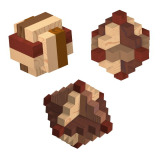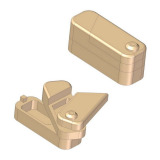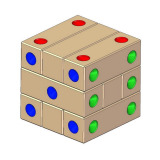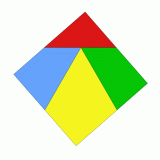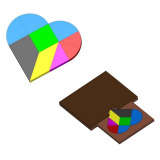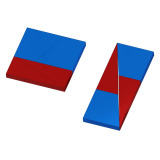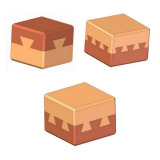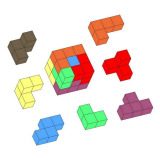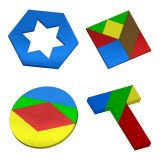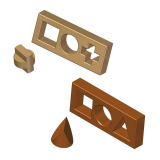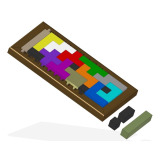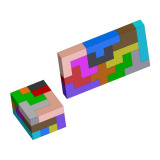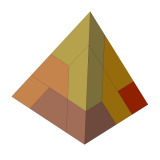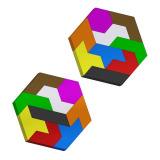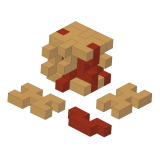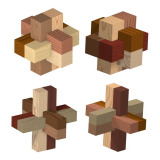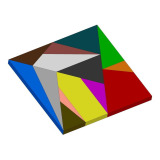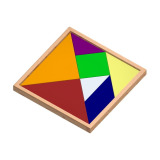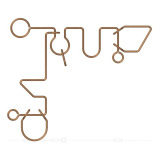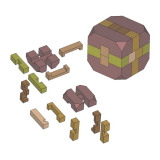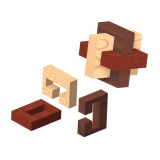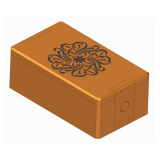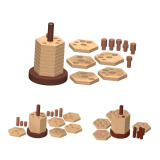Here you can find various free plans for puzzles of different shapes, sizes, number of parts and solving difficulty.
You will find free puzzle plans for the Soma cube, tangram puzzle, wire puzzles, mechanical 3D wooden puzzles, wooden puzzle box and many other puzzles and solving them will mentally challenge you, but here are also the ones – like wooden chain – that will be a real challenge to manufacture. Puzzle plans are designed for making wooden puzzles and wire puzzles. Wooden puzzles are equally attractive for both children and adults. The simple ones with less parts will be ideal for children, while more complex puzzles with more parts will challenge the adults.
- About the dissection puzzles
- About the Burr Puzzles
- Burr puzzle terminology
- How to make burr puzzles
Wooden puzzle can be an ideal toy for the children and an interesting amusement for the adults. It is an important tool for the children for learning and stimulating their development. By using 3D puzzles children develop their capability to maintain the attention and learn how to organize their educational process. While solving the puzzles they reveal importance of the patience and the benefit to persist in unriddling the problem, they practice the hand-eye coordination, develop visualization and creativity, practice recognition and mutual relations between shapes, sizes and colors.
On this page you can download three plans by which you can make three different burr puzzles in your workshop.
This puzzle box looks quite simple and you can not see anything unusual on it, but when you try to open it, you will see that this is not easy at all.
Here you can download the plan for creating a 3D wooden puzzle. Since it looks like a dice, we have called it a dice puzzle.
The essence of haberdasher’s problem is how to cut an equilateral triangle into four pieces that could make a square.
With this simple free project you can make a Heart dissection puzzle, a perfect way for kids to spend quality time.
In various books and internet websites you can find a puzzle called Impossible area puzzle.
In front of you is the dovetail joint puzzle plan. This puzzle at a first glance look like object that is impossible to manufacture – and the task is to discover how it is made.
This is a project with which you can make the famous solid dissection puzzle known as the Soma cube.
This is a collection of plans for making lesser known dissection puzzles, but no less interesting ones.
In this plan we represented two examples of Multiple silhouette puzzle, but from the explanation below and drawings, it is clear that you can invent new versions of this puzzle.
Here you are presented with a plan according to which you can make an interesting Pentomino board game (Pentomino puzzle).
Here you can download a plan for making a famous pentomino puzzle, a perfect educational puzzle for children.
In front of you is a plan for the making of the Pyramid puzzle, very interesting puzzle but quite difficult to make.
With this free project you can make a Rhombic blocks dissection puzzle, easy to make and interesting to solve.
Here you can download a plan for making a simple wooden 3D puzzle, a perfect game for both children and adults.
If you like burr puzzles, here are four plans to help you create different six-piece burr puzzles, which represent the most famous, and probably the oldest type of burr puzzles.
With this simple free project you can make a Stomachion of Archimedes puzzle, a perfect way for kids to develop their logic skills while still having fun.
With the free project that you can download on this page you can make a famous dissection puzzle Tangram, a perfect educational gift for kids.
Here you can download a plan for making a wire puzzle. The wire puzzle, as its very name suggests, is made from wire and consists of two or several interlocked parts.
This puzzle, which is simply called the ‘interlocking puzzle’, consists of 12 parts and can be made from wood.
We are offering you a free plan of how to make your own wooden knot puzzle. The knot puzzle is an extremely simple puzzle which has the shape of a 3D Greek cross.
This wooden puzzle box, whose plan we are offering here to you, is quite interesting because it has two opening mechanisms.
Here you can download a plan to create three variants of the same puzzle. We have called it the ‘stacker puzzle’ because of the way it is put together.
By its definition puzzle represents a problem or situation that is difficult to understand and to solve. Puzzle is a very broad term that can occur in a form of question, game or a toy and it represents a mental challenge aimed to find the solution. Solving the puzzle is testing our knowledge, intelligence, capability, patience and ingenuity. Puzzles are often confusing and at first they offer an easy but false solution, so for the correct solution a man needs logical thinking and intelligence. In a form of toy, puzzles consist out of separated parts, its assemblage is complicated and requires logical thinking, intelligence and patience in order to put the parts together correctly. At a first glance, puzzles are fun and entertaining, but they often consist out of numerous mathematical and logistical problems, so by taking in consideration how many skills they require to be solved, they are an ideal educative tool that develops and sharpen the logical thinking.
Wooden puzzle are great way to use various scrap wood pieces that remained in the workshop. They consist out of the small parts, so the small wood scraps can be used. For some puzzle it is not important to be made out of the same type of wood - they will look even better if you make them out of different types of wood with different natural colors. If they are made this way, the only investment that is needed is your work, and the material does not require money investment.
To make wooden puzzle, the first thing you should do is to decide which puzzle you want to make, how complex it should be and what are your capabilities for required wood working. You should carefully analyze the puzzle plan and very precisely cut and sand the puzzle parts. This is very important because even the minimal digression from the specified dimensions can lead to the problems during puzzle assemblage. The parts should be sanded very well, so they can slip easily during the puzzle assembling and disassembling, and to avoid hand injuries by wood splinters while playing with puzzle. If you wish you can paint the puzzle or apply finish. We recommend to make wooden box or a cloth bag to keep your puzzle, because the loss of even one part will take all the charm of your puzzle and it is very likely that it will thus become completely useless.
There are thousands of ways for making wooden puzzles. Their complexity depends on your imagination and wood working skills, also how challenging you want the puzzles to be and on the age and capacity of the persons to which they are dedicated.
Puzzles exist for quite a long time throughout the history. It is not confirmed precisely in which period or which country the puzzles originated from. The oldest known mechanical puzzles came from the Greece in the 3rd Century B.C. They were consisting out of a square divided in 14 pieces, and the goal was to construct various shapes from those pieces. The ring puzzles were mentioned in China at the beginning of the 2nd century A.D. For centuries, the wooden boxes with the secret opening mechanisms – and they can also be considered as puzzles – were used for safekeeping jewelry and other valuables. The wooden Jig-saw puzzle as we know it today is mentioned about the year 1760. Such a first puzzle was a map, made for educational purpose and each country represented one piece of puzzle. In the 18th Century the puzzles are mentioned in Japan, then the Tangram puzzle in China and shortly after they arrived in Europe and America. Today puzzles are an integral part of life of almost all people, even if we are often not aware of it, because the crosswords, dominoes, chess, Rubik's Cube, and even video games for mobile phones and various computer games fall under the puzzle category. There are many types of puzzles today. Based on the theme, solution methods, materials being used for puzzles or other characteristics of the puzzle itself, some of the basic puzzle types are: situation puzzles (lateral thinking puzzles), logic puzzles, paper-and-pencil puzzles, mathematical puzzles, construction puzzles, wire puzzles, mechanical puzzles, dissection puzzles, jigsaw puzzles, lock puzzles, stick puzzles, sliding puzzles, tiling puzzles, disentanglement puzzles, folding puzzles, combination puzzles, tour puzzles, transport puzzles and many other types. Some of the puzzles even fall into several categories.
Puzzles are equally attractive to both children and adults. To the children they are the perfect educational toy that can keep children's attention for a long time and strongly encourage mental and motor abilities development, and for the adults they are a quality pastime that can fully engage the brain and hands and this way help to relieve the stress, to exercise patience and sharpen the mind and concentration. Depending on the puzzle type and complexity it can be designed for one or more persons. The fact if the puzzle is considered to be simple or complex depends primarily on the ability of the person who is solving it. The puzzle type and complexity needs to be adjusted to the age and mental capacity of the person who solves it, while the simple puzzle will be uninteresting to the adult person and the complex puzzles that require complex skills will frustrate and not be pleasurable to the children and to the people that do not posses necessary skills. Successful solving of puzzle, which some person will evaluate as a difficult puzzle according to their capability, will have positive effect on self-confidence and pride and it will motivate it to take more and more complex problems.
